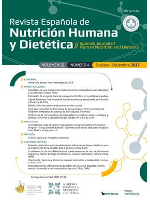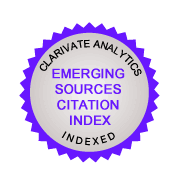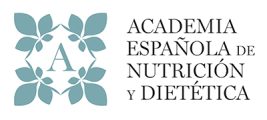Barriers to healthy eating questionnaire (C-BASU) in mexican college students: construction and evidence of validity
Barriers to Healthy Eating Questionnaire (C-BASU)
DOI:
https://doi.org/10.14306/renhyd.29.2.2314Keywords:
Young Adult, Life Style, access to healthy foods, desingAbstract
Introduction: Entering University implies adopting a self-managed lifestyle, due to the increased academic load and rigor. Faced with such a scenario, many university students prioritize their academic responsibilities, neglecting their nutrition. The barriers to healthy eating have been classified into three types: intrapersonal-individual, interpersonal-social environmental and contextual-physical environmental. So far, these barriers have been explored only in qualitative research, therefore, the objective of this study was to construct a valid and reliable questionnaire that measures the barriers perceived by students to healthy eating, under an instrumental design.
Methodology: 2,405 Mexican college students participated. Construct validity was verified using the cross-validation method. Two subsamples were created: the first (n= 605) was used for exploratory factor analysis (EFA) and the second (n= 1800) for confirmatory factor analysis (CFA). Reliability indices were calculated for each factor with Cronbach's Alpha and McDonald's Omega coefficients. CFA was performed using the diagonal weighted least squares method. The goodness of fit of the data was assessed with the CFI, RMSEA and SRMR indices.
Results: With the EFA, an eight-factor structure was obtained with adequate reliability and with the minimum number of items necessary to adequately represent the content of each factor. The CFA obtained very good fit indices. Reliability results and the convergent validity estimates were also acceptable.
Conclusions: The presented questionnaire is valid and reliable for the assessment of barriers to healthy eating in college students. The use of this tool can contribute to the development of institutional strategies to facilitate healthy eating among their students and not only its promotion. Its use is suggested both in clinical practice and in research.
Funding: Universidad Autónoma de Aguascalientes, México funded this study.
References
(1) Leinberger-Jabari A, Al-Ajlouni Y, Ieriti M, Cannie S, Mladenovic M, Ali R Assessing motivators and barriers to active healthy living among a multicultural college student body: A qualitative inquiry. J Am Coll Health. 2023;71(2):338-42, doi: 10.1080/07448481.2021.1898403.
(2) Ramón-Arbués E, Martínez Abadía B, Granada López JM, Echániz Serrano E, Pellicer García B, Juárez Vela R, et al. Eating behavior and relationships with stress, anxiety, depression and insomnia in university students. Nutr Hosp. 2019, doi: 10.20960/nh.02641.
(3) Muñoz-Galeano ME, López-Restrepo S Caracterización del entorno alimentario de una universidad en Medellín, Colombia: retos para la promoción de una alimentación saludable. Rev Chil Nutr. 2024;51(1):76-85, doi: 10.4067/s0717-75182024000100076.
(4) Arrazat L, Nicklaus S, De Lauzon-Guillain B, Marty L Identification of three dietary groups in French university students and their associations with nutritional quality and environmental impact. Front Nutr. 2023;10:1323648, doi: 10.3389/fnut.2023.1323648.
(5) Bernardo GL, Jomori MM, Fernandes AC, Proença RPDC Food intake of university students. Rev Nutr. 2017;30(6):847-65, doi: 10.1590/1678-98652017000600016.
(6) Deliens T, Deforche B, Chapelle L, Clarys P Changes in weight and body composition across five years at university: A prospective observational study. PLOS ONE. 2019;14(11):e0225187, doi: 10.1371/journal.pone.0225187.
(7) Vadeboncoeur C, Townsend N, Foster C A meta-analysis of weight gain in first year university students: is freshman 15 a myth? BMC Obes. 2015;2(1):22, doi: 10.1186/s40608-015-0051-7.
(8) Li X, Braakhuis A, Li Z, Roy R How Does the University Food Environment Impact Student Dietary Behaviors? A Systematic Review. Front Nutr. 2022;9:840818, doi: 10.3389/fnut.2022.840818.
(9) Greaney ML, Less FD, White AA, Dayton SF, Riebe D, Blissmer B, et al. College Students’ Barriers and Enablers for Healthful Weight Management: A Qualitative Study. J Nutr Educ Behav. 2009;41(4):281-6, doi: 10.1016/j.jneb.2008.04.354.
(10) Hilger J, Loerbroks A, Diehl K Eating behaviour of university students in Germany: Dietary intake, barriers to healthy eating and changes in eating behaviour since the time of matriculation. Appetite. 2017;109:100-7, doi: 10.1016/j.appet.2016.11.016.
(11) Hilger-Kolb J, Diehl K ‘Oh God, I Have to Eat Something, But Where Can I Get Something Quickly?’—A Qualitative Interview Study on Barriers to Healthy Eating among University Students in Germany. Nutrients. 2019;11(10):2440, doi: 10.3390/nu11102440.
(12) Amore L, Buchthal OV, Banna JC Identifying perceived barriers and enablers of healthy eating in college students in Hawai’i: a qualitative study using focus groups. BMC Nutr. 2019;5(1):16, doi: 10.1186/s40795-019-0280-0.
(13) Abdelhafez AI, Akhter F, Alsultan AA, Jalal SM, Ali A Dietary Practices and Barriers to Adherence to Healthy Eating among King Faisal University Students. Int J Environ Res Public Health. 2020;17(23):8945, doi: 10.3390/ijerph17238945.
(14) Duarte Cuervo CY, Ramos Caballero DM, Latorre Guapo AC, González Robayo PN Factores relacionados con las prácticas alimentarias de estudiantes de tres universidades de Bogotá. Rev Salud Pública. 2016;17(6):925-37, doi: 10.15446/rsap.v17n6.38368.
(15) Sogari G, Velez-Argumedo C, Gómez M, Mora C College Students and Eating Habits: A Study Using An Ecological Model for Healthy Behavior. Nutrients. 2018;10(12):1823, doi: 10.3390/nu10121823.
(16) Vélez-Toral M, Rodríguez-Reinado C, Ramallo-Espinosa A, Andrés-Villas M “It’s Important but, on What Level?”: Healthy Cooking Meanings and Barriers to Healthy Eating among University Students. Nutrients. 2020;12(8):2309, doi: 10.3390/nu12082309.
(17) Lima JPM, Costa SA, Brandão TRS, Rocha A Food Consumption Determinants and Barriers for Healthy Eating at the Workplace—A University Setting. Foods. 2021;10(4):695, doi: 10.3390/foods10040695.
(18) Barbosa R, Henriques P, Guerra H, Emerentino J, Soares D, Dias P, et al. Food environment of a Brazilian public university: challenges to promote healthy eating. Rev Chil Nutr. 2020;47(3):443-8, doi: 10.4067/S0717-75182020000300443.
(19) Hernández-Nieto Ph D, Rafael Instrumentos de recolección de datos en ciencias sociales y ciencias biomédicas. 1a ed. Mérida, Venezuela: Universdidad de los Andes; 2011.
(20) American Educational Research Association, American Psychological Association, National Council on Measurement in Education Estándares para Pruebas Educativas y Psicológicas. American Educational Research Association; 2018.
(21) Aiken LR, Groth-Marnat G Psychological testing and assessment. 12th ed. Boston: Allyn and Bacon; 2006.
(22) Watkins MW A step-by-step guide to exploratory factor analysis with R and Rstudio. New York, NY London: Routledge; 2021.
(23) Tabachnick BG, Fidell LS Using multivariate statistics. 3rd ed. New York, NY: HarperCollins College Publishers; 1996.
(24) Kline RB Principles and practice of structural equation modeling. Fourth edition. New York: The Guilford Press; 2016.
(25) Moral De La Rubia J Revisión de los criterios para validez convergente estimada a través de la Varianza Media Extraída. Psychologia. 2019;13(2):25-41, doi: 10.21500/19002386.4119.
(26) Svetina D, Rutkowski L, Rutkowski D Multiple-Group Invariance with Categorical Outcomes Using Updated Guidelines: An Illustration Using M plus and the lavaan/semTools Packages. Struct Equ Model Multidiscip J. 2020;27(1):111-30, doi: 10.1080/10705511.2019.1602776.
(27) Fornell C, Larcker DF Evaluating Structural Equation Models with Unobservable Variables and Measurement Error. J Mark Res. 1981;18(1):39, doi: 10.2307/3151312.
(28) Escoto KH, Laska MN, Larson N, Neumark-Sztainer D, Hannan PJ Work Hours and Perceived Time Barriers to Healthful Eating Among Young Adults. Am J Health Behav. 2012;36(6):786-96, doi: 10.5993/AJHB.36.6.6.
(29) Organización Mundial de la Salud El desafío de la nutrición: soluciones desde los sistemas alimentarios. s. f.
(30) Shamah-Levy T, Méndez-Gómez Humarán I, Mundo-Rosas V, Rodríguez-Ramírez S, Gaona-Pineda EB Factores asociados con el cambio en la inseguridad alimentaria en México: Ensanut 2012 y 2018-19. Salud Pública México. 2021;63(3 May-Jun):350-8, doi: 10.21149/12145.
Additional Files
Published
How to Cite
Issue
Section
License
Copyright (c) 2020 Ma. de los Ángeles Vacio Muro, Roberto Lagunes-Córdoba, Martha Leticia Salazar Garza, María Luisa Marván

This work is licensed under a Creative Commons Attribution-NonCommercial-ShareAlike 4.0 International License.











